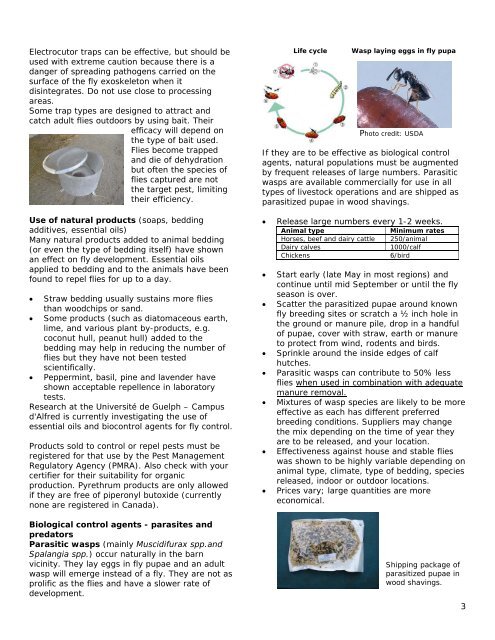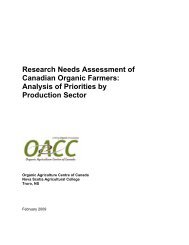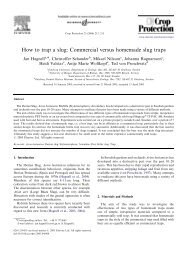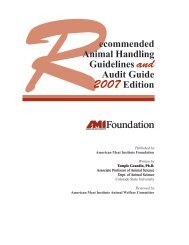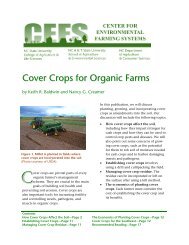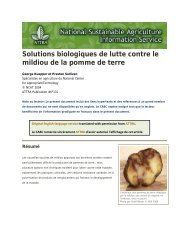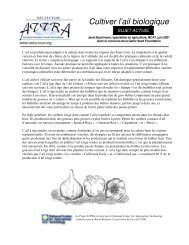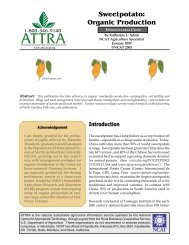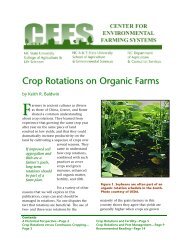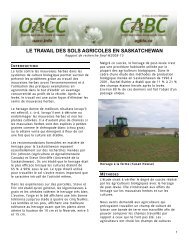management of pest flies on organic farms - Le centre d'agriculture ...
management of pest flies on organic farms - Le centre d'agriculture ...
management of pest flies on organic farms - Le centre d'agriculture ...
Create successful ePaper yourself
Turn your PDF publications into a flip-book with our unique Google optimized e-Paper software.
Electrocutor traps can be effective, but should beused with extreme cauti<strong>on</strong> because there is adanger <str<strong>on</strong>g>of</str<strong>on</strong>g> spreading pathogens carried <strong>on</strong> thesurface <str<strong>on</strong>g>of</str<strong>on</strong>g> the fly exoskelet<strong>on</strong> when itdisintegrates. Do not use close to processingareas.Some trap types are designed to attract andcatch adult <str<strong>on</strong>g>flies</str<strong>on</strong>g> outdoors by using bait. Theirefficacy will depend <strong>on</strong>the type <str<strong>on</strong>g>of</str<strong>on</strong>g> bait used.Flies become trappedand die <str<strong>on</strong>g>of</str<strong>on</strong>g> dehydrati<strong>on</strong>but <str<strong>on</strong>g>of</str<strong>on</strong>g>ten the species <str<strong>on</strong>g>of</str<strong>on</strong>g><str<strong>on</strong>g>flies</str<strong>on</strong>g> captured are notthe target <str<strong>on</strong>g>pest</str<strong>on</strong>g>, limitingtheir efficiency.Use <str<strong>on</strong>g>of</str<strong>on</strong>g> natural products (soaps, beddingadditives, essential oils)Many natural products added to animal bedding(or even the type <str<strong>on</strong>g>of</str<strong>on</strong>g> bedding itself) have shownan effect <strong>on</strong> fly development. Essential oilsapplied to bedding and to the animals have beenfound to repel <str<strong>on</strong>g>flies</str<strong>on</strong>g> for up to a day.• Straw bedding usually sustains more <str<strong>on</strong>g>flies</str<strong>on</strong>g>than woodchips or sand.• Some products (such as diatomaceous earth,lime, and various plant by-products, e.g.coc<strong>on</strong>ut hull, peanut hull) added to thebedding may help in reducing the number <str<strong>on</strong>g>of</str<strong>on</strong>g><str<strong>on</strong>g>flies</str<strong>on</strong>g> but they have not been testedscientifically.• Peppermint, basil, pine and lavender haveshown acceptable repellence in laboratorytests.Research at the Université de Guelph – Campusd'Alfred is currently investigating the use <str<strong>on</strong>g>of</str<strong>on</strong>g>essential oils and bioc<strong>on</strong>trol agents for fly c<strong>on</strong>trol.Products sold to c<strong>on</strong>trol or repel <str<strong>on</strong>g>pest</str<strong>on</strong>g>s must beregistered for that use by the Pest ManagementRegulatory Agency (PMRA). Also check with yourcertifier for their suitability for <strong>organic</strong>producti<strong>on</strong>. Pyrethrum products are <strong>on</strong>ly allowedif they are free <str<strong>on</strong>g>of</str<strong>on</strong>g> piper<strong>on</strong>yl butoxide (currentlyn<strong>on</strong>e are registered in Canada).Biological c<strong>on</strong>trol agents - parasites andpredatorsParasitic wasps (mainly Muscidifurax spp.andSpalangia spp.) occur naturally in the barnvicinity. They lay eggs in fly pupae and an adultwasp will emerge instead <str<strong>on</strong>g>of</str<strong>on</strong>g> a fly. They are not asprolific as the <str<strong>on</strong>g>flies</str<strong>on</strong>g> and have a slower rate <str<strong>on</strong>g>of</str<strong>on</strong>g>development.Life cycleWasp laying eggs in fly pupaPhoto credit: USDAIf they are to be effective as biological c<strong>on</strong>trolagents, natural populati<strong>on</strong>s must be augmentedby frequent releases <str<strong>on</strong>g>of</str<strong>on</strong>g> large numbers. Parasiticwasps are available commercially for use in alltypes <str<strong>on</strong>g>of</str<strong>on</strong>g> livestock operati<strong>on</strong>s and are shipped asparasitized pupae in wood shavings.• Release large numbers every 1-2 weeks.Animal typeHorses, beef and dairy cattleDairy calvesChickensMinimum rates250/animal1000/calf6/bird• Start early (late May in most regi<strong>on</strong>s) andc<strong>on</strong>tinue until mid September or until the flyseas<strong>on</strong> is over.• Scatter the parasitized pupae around knownfly breeding sites or scratch a ½ inch hole inthe ground or manure pile, drop in a handful<str<strong>on</strong>g>of</str<strong>on</strong>g> pupae, cover with straw, earth or manureto protect from wind, rodents and birds.• Sprinkle around the inside edges <str<strong>on</strong>g>of</str<strong>on</strong>g> calfhutches.• Parasitic wasps can c<strong>on</strong>tribute to 50% less<str<strong>on</strong>g>flies</str<strong>on</strong>g> when used in combinati<strong>on</strong> with adequatemanure removal.• Mixtures <str<strong>on</strong>g>of</str<strong>on</strong>g> wasp species are likely to be moreeffective as each has different preferredbreeding c<strong>on</strong>diti<strong>on</strong>s. Suppliers may changethe mix depending <strong>on</strong> the time <str<strong>on</strong>g>of</str<strong>on</strong>g> year theyare to be released, and your locati<strong>on</strong>.• Effectiveness against house and stable <str<strong>on</strong>g>flies</str<strong>on</strong>g>was shown to be highly variable depending <strong>on</strong>animal type, climate, type <str<strong>on</strong>g>of</str<strong>on</strong>g> bedding, speciesreleased, indoor or outdoor locati<strong>on</strong>s.• Prices vary; large quantities are moreec<strong>on</strong>omical.Shipping package <str<strong>on</strong>g>of</str<strong>on</strong>g>parasitized pupae inwood shavings.3


